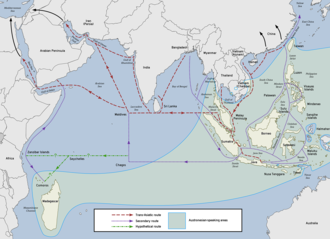Filipino cuisine
Filipino Cuisine[edit]

Filipino cuisine is a rich and diverse culinary tradition that reflects the history and culture of the Philippines. It is characterized by a combination of sweet, sour, and salty flavors, often with a hint of spice. The cuisine has been influenced by various cultures, including Malay, Chinese, Spanish, and American, among others.
History[edit]
The history of Filipino cuisine is deeply intertwined with the country's history of trade and colonization. The Austronesian peoples who first settled in the Philippines brought with them cooking techniques and ingredients that are still used today.

During the Spanish colonial period, new ingredients such as tomatoes, potatoes, and chili peppers were introduced, along with cooking methods like sautéing and braising. The Chinese influence is evident in dishes like lumpia and pancit, while the American period introduced canned goods and fast food culture.
Common Ingredients[edit]
Filipino cuisine makes extensive use of local ingredients such as coconut, rice, and fish.

- Rice: A staple in every Filipino meal, rice is often served steamed or fried.
- Coconut: Used in various forms, including coconut milk and coconut vinegar.
- Fish and Seafood: The archipelagic nature of the Philippines makes fish and seafood abundant and integral to the diet.
- Fruits and Vegetables: Tropical fruits like mangoes and bananas, as well as vegetables like eggplant and bitter melon, are commonly used.
Popular Dishes[edit]

- Adobo: A popular dish made with meat, usually chicken or pork, marinated in vinegar, soy sauce, garlic, and spices.
- Sinigang: A sour soup made with meat or seafood and flavored with tamarind or other sour fruits.
- Lechon: A whole roasted pig, often served during special occasions.
- Pinakbet: A vegetable dish made with squash, eggplant, and bitter melon, flavored with shrimp paste.
Desserts[edit]
Filipino desserts are known for their use of sweet and rich ingredients.

- Halo-halo: A popular dessert made with crushed ice, evaporated milk, and various ingredients like sweetened beans, fruits, and ube (purple yam).
- Leche flan: A rich custard dessert topped with caramel.
- Ube halaya: A sweet purple yam jam often used in other desserts.
Dining Culture[edit]

Filipino dining culture is communal, with meals often shared among family and friends. A unique dining experience is the "boodle fight", where food is served on banana leaves and eaten with hands.
Breakfast[edit]

Breakfast in the Philippines often includes "silog" meals, which consist of garlic fried rice, a fried egg, and a choice of meat such as tapa (cured beef), longganisa (sausage), or tocino (sweet cured pork).
Related Pages[edit]
Ad. Transform your life with W8MD's Budget GLP-1 injections from $75


W8MD offers a medical weight loss program to lose weight in Philadelphia. Our physician-supervised medical weight loss provides:
- Weight loss injections in NYC (generic and brand names):
- Zepbound / Mounjaro, Wegovy / Ozempic, Saxenda
- Most insurances accepted or discounted self-pay rates. We will obtain insurance prior authorizations if needed.
- Generic GLP1 weight loss injections from $75 for the starting dose.
- Also offer prescription weight loss medications including Phentermine, Qsymia, Diethylpropion, Contrave etc.
NYC weight loss doctor appointmentsNYC weight loss doctor appointments
Start your NYC weight loss journey today at our NYC medical weight loss and Philadelphia medical weight loss clinics.
- Call 718-946-5500 to lose weight in NYC or for medical weight loss in Philadelphia 215-676-2334.
- Tags:NYC medical weight loss, Philadelphia lose weight Zepbound NYC, Budget GLP1 weight loss injections, Wegovy Philadelphia, Wegovy NYC, Philadelphia medical weight loss, Brookly weight loss and Wegovy NYC
|
WikiMD's Wellness Encyclopedia |
| Let Food Be Thy Medicine Medicine Thy Food - Hippocrates |
Medical Disclaimer: WikiMD is not a substitute for professional medical advice. The information on WikiMD is provided as an information resource only, may be incorrect, outdated or misleading, and is not to be used or relied on for any diagnostic or treatment purposes. Please consult your health care provider before making any healthcare decisions or for guidance about a specific medical condition. WikiMD expressly disclaims responsibility, and shall have no liability, for any damages, loss, injury, or liability whatsoever suffered as a result of your reliance on the information contained in this site. By visiting this site you agree to the foregoing terms and conditions, which may from time to time be changed or supplemented by WikiMD. If you do not agree to the foregoing terms and conditions, you should not enter or use this site. See full disclaimer.
Credits:Most images are courtesy of Wikimedia commons, and templates, categories Wikipedia, licensed under CC BY SA or similar.
Translate this page: - East Asian
中文,
日本,
한국어,
South Asian
हिन्दी,
தமிழ்,
తెలుగు,
Urdu,
ಕನ್ನಡ,
Southeast Asian
Indonesian,
Vietnamese,
Thai,
မြန်မာဘာသာ,
বাংলা
European
español,
Deutsch,
français,
Greek,
português do Brasil,
polski,
română,
русский,
Nederlands,
norsk,
svenska,
suomi,
Italian
Middle Eastern & African
عربى,
Turkish,
Persian,
Hebrew,
Afrikaans,
isiZulu,
Kiswahili,
Other
Bulgarian,
Hungarian,
Czech,
Swedish,
മലയാളം,
मराठी,
ਪੰਜਾਬੀ,
ગુજરાતી,
Portuguese,
Ukrainian